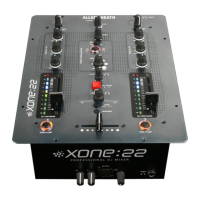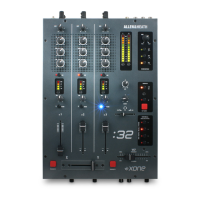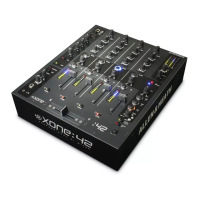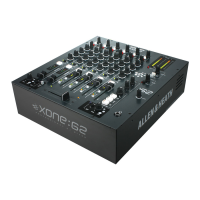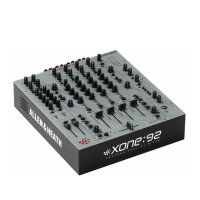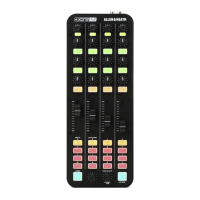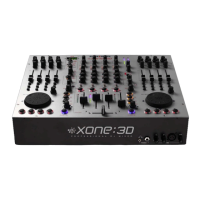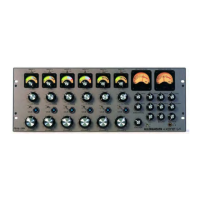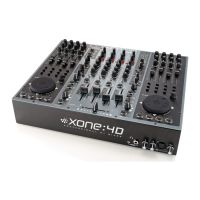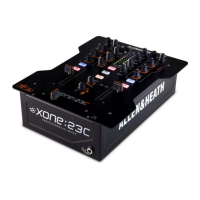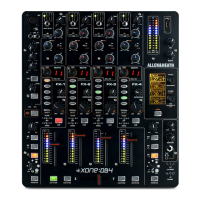20 XONE:02 User Guide
Glossary
The following section is included to help you understand some of the technical terms and jargon
referred to with consoles of this type. It is by no means a complete reference. Please refer to specialist
audio publications should you wish to know more.
Amplitude Another term used for signal level.
Asymmetric EQ An equaliser with a different amount
of cut and boost of the frequency bands. This is used
to restrict the available boost so preventing system
overload while providing extended cut to allow
dramatic performance effects by ‘killing’ selected
frequencies.
Attenuate Reduce the signal level.
Aux Auxiliary. An independent mix derived from the
channels for various functions. This can be set pre
(before) or post (after) the channel fader. Pre-fade
sends are often used for foldback monitor feeds. Post-
fade sends are often used for sampler, reverb and
other effects, zone and special recording feeds.
Balanced, Unbalanced Refers to the type of input or
output signal connection. An unbalanced connection
has two signal carrying conductors, one of which is the
cable shield. A balanced connection has three
conductors, two for signal and a shield which is
connected to earth. Because the signal conductors
are at the same impedance and of opposite polarity
they are better able to cancel and therefore reject
interference and noise pickup. It is standard practice
to use balanced connections for long cable runs, for
example to amplifiers, or cables carrying sensitive or
low level signals, for example microphones.
Battle Mixing The competitive sport where DJs try to
kill each other with their performance…
Beat Mixing Using the variable pitch controls on
turntables/CD players to synchronise the rhythm track
of two separate songs, so that the beat remains
constant when smoothly cross-fading from one to the
other.
Bi-amping Providing separate amplifiers to drive the
high and low frequency units in a loudspeaker. This
requires a crossover processor that splits the
frequency band into low and high. Bi-amping usually
produces a cleaner and more controllable sound in
larger systems.
BPM Beats Per Minute. The measurement of the
rhythmic beat or tempo of the music.
Booth The area, often enclosed, where the DJ
operates. Usually provided with local booth monitor
loudspeakers.
Cardioid The response of a microphone which is
more sensitive in front than behind. This is generally
used for vocal miking to reduce acoustic feedback.
Cartridge The pickup in a turntable. Uses a needle
to pick up vibrations from the record (vinyl) and
convert this to electrical signals that feed the console.
The cartridge is usually fitted to a removable headshell
that plugs into the turntable arm.
Clipping The harsh distorted sound that results when
the signal hits the maximum level possible. This is set
by the power rail voltage. Above this there is simply
no more voltage available so the signal is ‘clipped’.
Compact Disc (CD) Well established stereo player
using digitally mastered pre-recorded flat discs.
Becoming popular with DJs as a replacement or
alternative to vinyl mixing. Recordable CDs are now
available.
Contour The term used to describe the ‘law’ of a
fader, how quickly it responds as it is moved, or the
amount of fade per unit of movement. The contour
control associated with a crossfader lets the DJ tailor
its response to suit the preferred mixing style.
Crossfader A short horizontally mounted fader for
smoothly fading one music track in while fading the
other out. Often used by the DJ for cutting and
layering sounds while mixing.
Cue A monitor system provided for the DJ or console
operator to check individual channel signals using
headphones while lining up tracks ready to introduce
into the mix. This does not affect the main console
outputs.
Cut Mixing Moving the cross-fade control sharply
from one side to the other, to either pick out a sound, a
hi-hat, kick drum etc, or to drop straight into another
record. Also known as chopping.
DAT Digital Audio Tape. A type of digital 2 track
recorder that uses a small tape cartridge to produce
high quality recordings in a compact format.
dB Decibel. The unit of measurement for audio
signal level. This is logarithmic to follow the response
of the human ear. ‘dB’ is a relative measurement to
compare one level with another, for example gain from
input to output. ‘dBu’ is an absolute measurement
referenced to a voltage standard where 0dBu = 0.775V
rms. The console main outputs operate at 0dBu = ‘0’
reading on the meters. '’dBV’ is a similar
measurement but refers to a 1V standard. It is
common for consumer equipment to operate a the
‘low’ standard of –10dBV (316mV). ‘dBA’ refers to
sound pressure level and is measured using the ‘A’
scale that ‘hears’ in the same way as the human ear.
dB/octave Term used to specify the slope of an EQ
(equaliser) response. This is how quickly it cuts or
boosts relative to frequency.
DJ Disc Jockey. The console operator sequencing
and playing the music tracks. Some simply play the
tracks, others talk over with introductions and
announcements, and others provide an entertaining
performance by mixing and shaping sounds to create
a completely different musical experience.
Drum Machine An electronic drum simulator as used
by keyboard players and in electronic music. This now
provides another DJ tool to create an alternative beat
to mix in with the music.
Dynamic Range The difference expressed in dB
between the highest and lowest signal levels possible.
This is limited by the clipping level and residual noise
floor respectively.
Earth Also known as ‘ground’. The term for the
electronic signal reference. This connects to the
mains supply earth point and all cable shields and
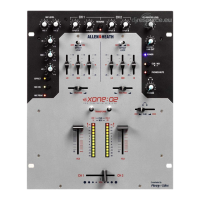
